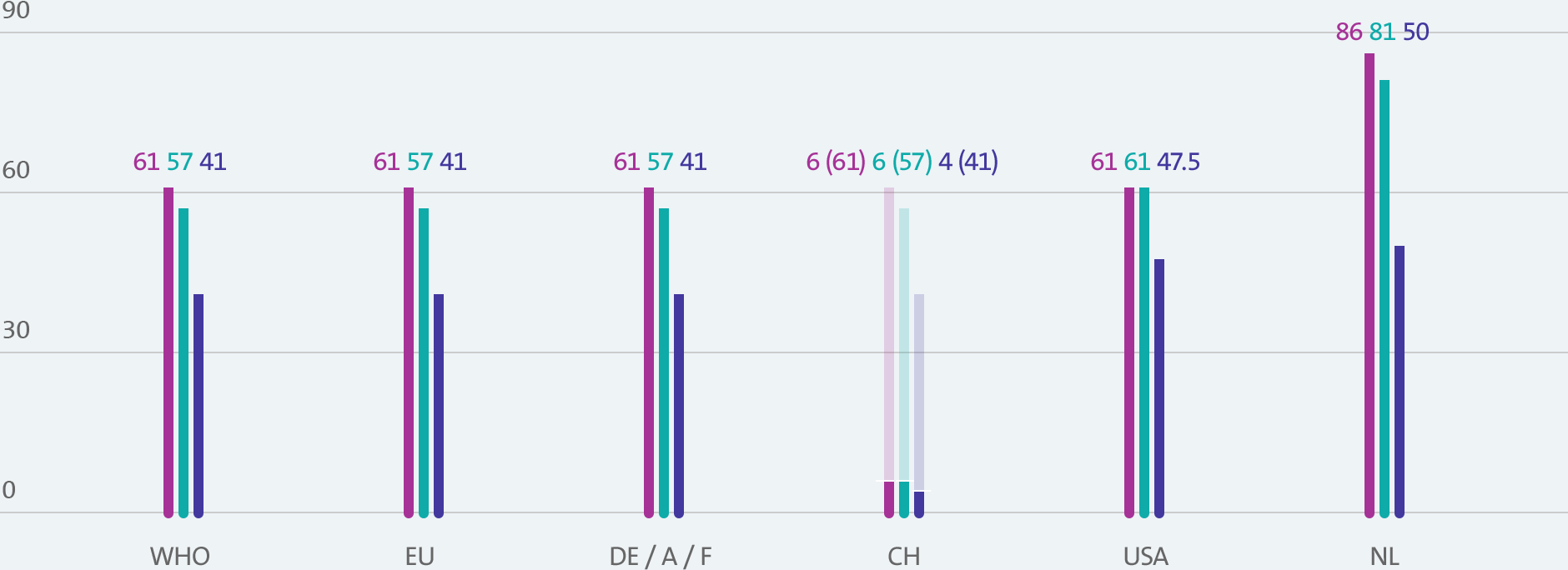Map of electric field strength
For the transmission (sending and receiving) of data, mobile communication masts generate electromagnetic fields, also known as non-ionizing electromagnetic radiation. You can now calculate the strength of these electric fields for each location in Switzerland on our map.
The map shows your location and the electromagnetic fields generated by Swisscom mobile communication masts in an area measuring two square kilometres. The lines show the field strength in volts per meter for the selected height above ground. The lines result from calculated points at a distance of 20 meters. The gradations are 0.5 V/m.
Limits for mobile radio
Most countries follow WHO [World Health Organisation] recommendations for threshold values. Yet in Switzerland, precautionary installation value limits are ten times stricter than in most EU countries.

 2100 MHz
2100 MHz 2600 MHz
2600 MHz 900 MHz
900 MHz
Electric field specifications in volts per metre. Rigorous precautionary threshold values apply in Switzerland especially for highly frequented places such as offices, apartments, schools and hospitals.
Source: IZMF Information Centre for Mobile Communications
Beamforming with 5G
With 5G we are introducing the latest mast technology, known as beamforming. Put simply, with this technology, the fields transmitted by the masts no longer cover a large area, but are more targeted and precise. This results in higher speeds and larger capacities within the network with lower average emissions.
Measuring electromagnetic radiation
We constantly check the output of our masts, comparing it with the approved key data once a day. Accredited measuring institutes also carry out many electromagnetic field measurements on our behalf in accordance with the federal government's prescribed methodology and we are developing more accurate measuring methods using the specially designed Niro measuring robot.
Electrosensitivity
Some people who suffer from health or well-being issues attribute the cause to electric fields, although there is no scientific proof or medical diagnosis of this. These complaints are real, however, and we support the efforts of the federal government in offering help to people who suffer from electrosensitivity.
Go to the Federal Office for the Environment(opens in new tab)
Do you have any questions about our
mobile phone antennas?
A team of experts in communication, mobile radio and health is there for you.
Links
Downloads
Calculation basis
The actual output and the daily mean value of all Swisscom masts within the two-kilometre square areas are used to calculate the field strengths. The field strength is calculated every 20 metres, at around 10,000 points. These values differ from the field strength values on the site data sheets. These calculate the maximum possible field strengths of a single system with the full approved transmitting power to the decimetre.
Field strengths
Our map shows the electrical field strength in volts per meter as usual. However, this field strength does not reflect the measurement data on site; it is automatically calculated from the output data of the masts under review and the selected terrain point. A daily mean value and plant utilisation are also included. The result is a realistic daily average. This should not be confused with the theoretical maximum value that must be stated in the location data sheets for the mobile communication installation.
Mobile communication masts are taken into account
This calculation includes the Swisscom masts and mast locations we share with our competitors but not separate competitor locations.
Calculated area
The field strengths are shown within a 2 × 2 km area. All mobile communication masts up to 500 m outside this range are included in the field strength calculation (3 ×3 km range).
Mobile communication masts
Actual radiation patterns of an antenna are used to calculate the field strength. The positions (spatial coordinates) of the antenna panels on a mast, for example, are calculated with an accuracy of +/- 10 cm.
Calculation method
There is a formula for open-space propagation. Topology and attenuation by buildings and vegetation is not considered. This means that the field strengths shown here tend to be an overestimate of the actual field strengths.